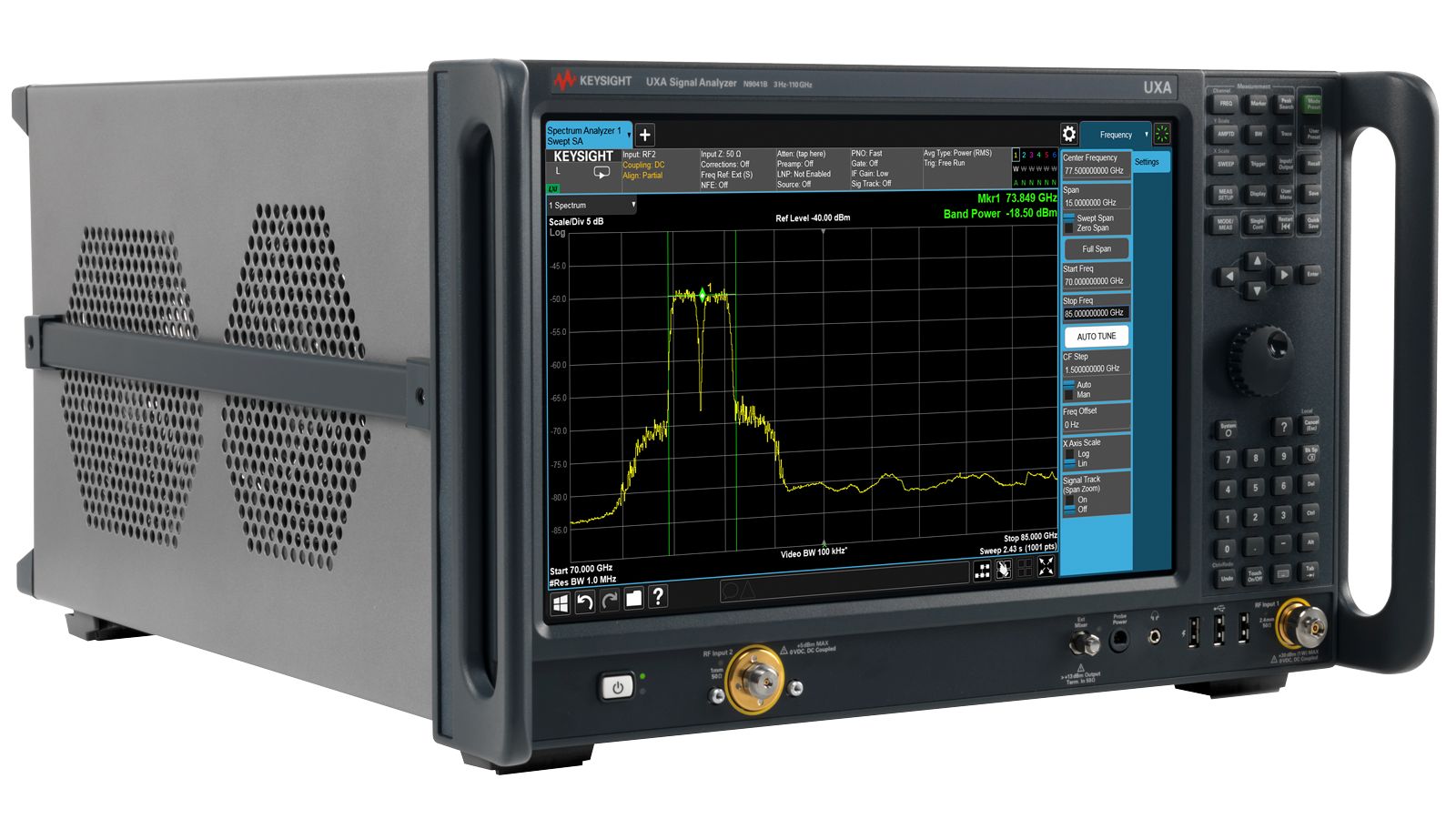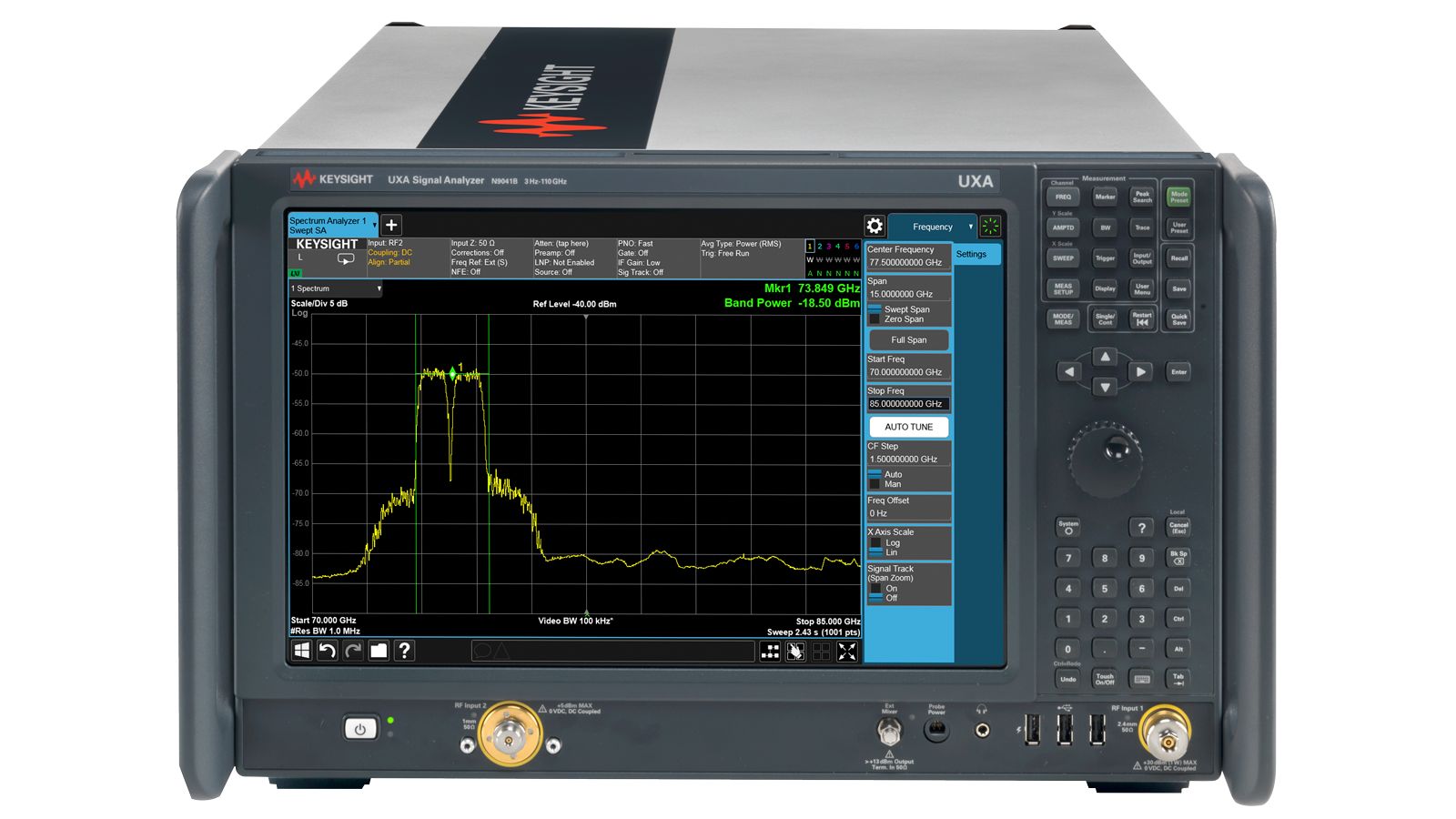Keysight N9041B-590
2 Hz to 90 GHz
List Price USD 371,710.00 Save 30% USD 260,197.00 Excl. taxes.
Cannot ship to:
European Union
Switzerland
Norway
Turkey
Unit only ships within China.
Unit ships worldwide.

Keysight Premium Used
Keysight N9041B-590
From
USD 260,197.00 Save 30%
| 590 | Frequency Range, 2 Hz to 90 GHz | Installed |
| H1G | Analysis bandwidth, 1 GHz | Installed |
| 1DVR001A | ROM/CD-R/RW drive | On request |
| 1MSE001A | Mouse | On request |
| MLP001A | Minimum loss pad, 50 to 75 ohm | On request |
| 12M | On request | |
| 24M | On request | |
| 2CM | Rack mount flange kit 265.9mm H (6U) - two flange brackets, two standard rails | On request |
| 2CP | Rack mount flange and handle kit 265.9mm H (6U) - two brackets, handles, rails | On request |
| 36M | On request | |
| 60M | On request | |
| ALV | Auxiliary log video output | On request |
| N90EMQAMB | WLAN 4096QAM modulation | On request |
| AMG | Calibration + Uncertainties + Guardbanding (Accredited) | On request |
| B40 | Analysis bandwidth, 40 MHz | On request |
| N90EMRBEB | Resolution Bandwidth Extended | On request |
| C12 | On request | |
| C36 | On request | |
| C60 | On request | |
| CRP | Connector rear, programmable IF output | On request |
| CRW | Connector, IF out, wide | On request |
| EA3 | Electronic attenuator, 3.6 GHz | On request |
| EDC | External digitizer control | On request |
| FBP | On request | |
| N6141EM0E | EMI Measurement Application | On request |
| E9068EM0E | On request | |
| N9054EM0E | Vector Modulation Analysis Digital Demodulation Measurement Application | On request |
| N9079EM0E | TD-Scdma/HSPA measurement application, remote control only | On request |
| N9080EM0E | LTE and LTE-Advanced FDD Measurement Application | On request |
| N9061EM0E | Remote Language Compatibility Measurement Application | On request |
| N9062EM0E | SCPI Language Compatibility Measurement Application | On request |
| N9063EM0E | Analog Demodulation Measurement Application | On request |
| N9067EM0E | Pulse Analysis Measurement Application | On request |
| N9068EM0E | Phase Noise Measurement Application | On request |
| N9069EM0E | Noise Figure Measurement Application | On request |
| N9071EM0E | GSM/EDGE/Evo Measurement Application | On request |
| N9072EM0E | cdma2000 measurement application, remote control only | On request |
| N9073EM0E | W-CDMA/HSPA+ Measurement Application | On request |
| N9076EM0E | 1xEV-DO measurement application, remote control only | On request |
| N9077EM0E | WLAN 802.11a/b/g/j/p/n/af/ah Measurement Application | On request |
| N9081EM0E | Bluetooth (TM) Measurement Application | On request |
| N9082EM0E | LTE and LTE-Advanced TDD Measurement Application | On request |
| N9083EM0E | On request | |
| N9084EM0E | Short Range Communications and IoT Measurement Application | On request |
| N9085EM0E | 5G NR Measurement Application | On request |
| N9054EM1E | Vector Modulation Analysis Custom OFDM Application | On request |
| N9080EM3E | NB-IoT and eMTC FDD Measurement Application | On request |
| N9077EM3E | On request | |
| N9077EM4E | On request | |
| N9080EM4E | LTE V2X measurement application | On request |
| N90EMEMCB | Basic EMC Functionality | On request |
| N90EMFP2B | Fast power | On request |
| P50 | Preamplifier, 50 GHz | On request |
| SF1 | Security features, exclude launching programs | On request |
| SF2 | Security features, prohibit saving results | On request |
| N90EMPSMB | Power Suite Measurement Application | On request |
| N90EMFT1B | Frequency Mask Trigger, Basic Detection | On request |
| N9041RT1B | Real-time analysis up to maximum available BW, Basic Detection | On request |
| N9041RT2B | Real-time analysis up to maximum available BW, Optimum Detection | On request |
| N90EMFT2B | Frequency Mask Trigger, Optimum Detection | On request |
| W10 | Operating system, Windows 10 | On request |
| YAV | Screen video, log video and linear video | On request |
Adding options and accessories may impact shipping times
Request a customized version of this model by requesting a Custom Quote
Deliver Your Next Breakthrough with our Most Advanced Signal Analysis Platform
The ultimate performance of our UXA signal analyzers lets you characterize today’s most challenging signals — fast-hopping, wideband, transient — in 5G, 802.11ax/ay, satellite, radar, electronic warfare (EW), and more. You’ll gain insight into the purity of your design with industry-leading phase noise and wide spurious-free dynamic range.
- Analyze bandwidth-hungry emerging standards such as 5G and automotive radar with up to 1 GHz internal analysis bandwidth and up to 5 GHz external
- Make continuous sweeps up to 110 GHz
- Capture lower-level spurious signals with DANL as low as -150 dBm/Hz (> 50 GHz)
- Record and analyze real-world environments with gap-free streaming up to 255 MHz
- Compatible with X-Series application, enabling you to simplify complex measurements and deliver repeatable results
- Add the real-time analysis option and detect signals as short as 3.51 µs
- See more and take your design farther with the 14.1-inch screen
For Keysight Premium Used listings like-new accessories (e. g. a power cord) are included.
Other accessories that are not listed and included in the offer can be purchased separately at an extra cost with your purchase of a Keysight Used or Keysight Premium Used unit. Please specify in the comment field which additional accessories or support you are interested in.
For separate or post-purchase ordering, please contact your local Keysight office or Keysight Partner here. Or check our online store if available for your region here.


















